SHARE
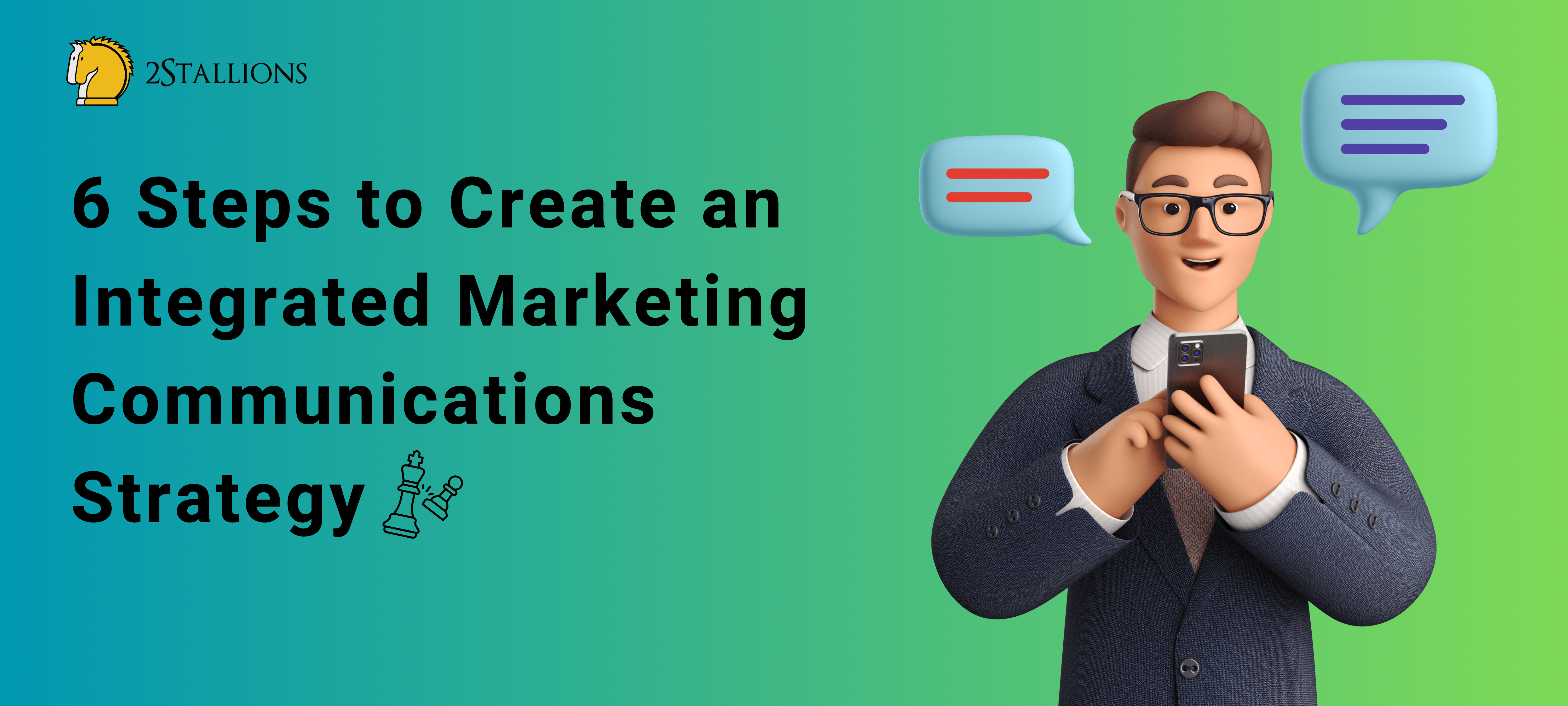
[thrive_leads id=’8334′]
Have you ever wondered how businesses seamlessly convey a unified message across various platforms in our interconnected world? Enter the realm of Integrated Marketing Communications (IMC), a strategic powerhouse that can redefine how your business communicates. Let’s embark on a journey through the 6 essential steps that unlock the potential of a robust IMC strategy, illustrated with practical examples to guide you through each transformative stage.
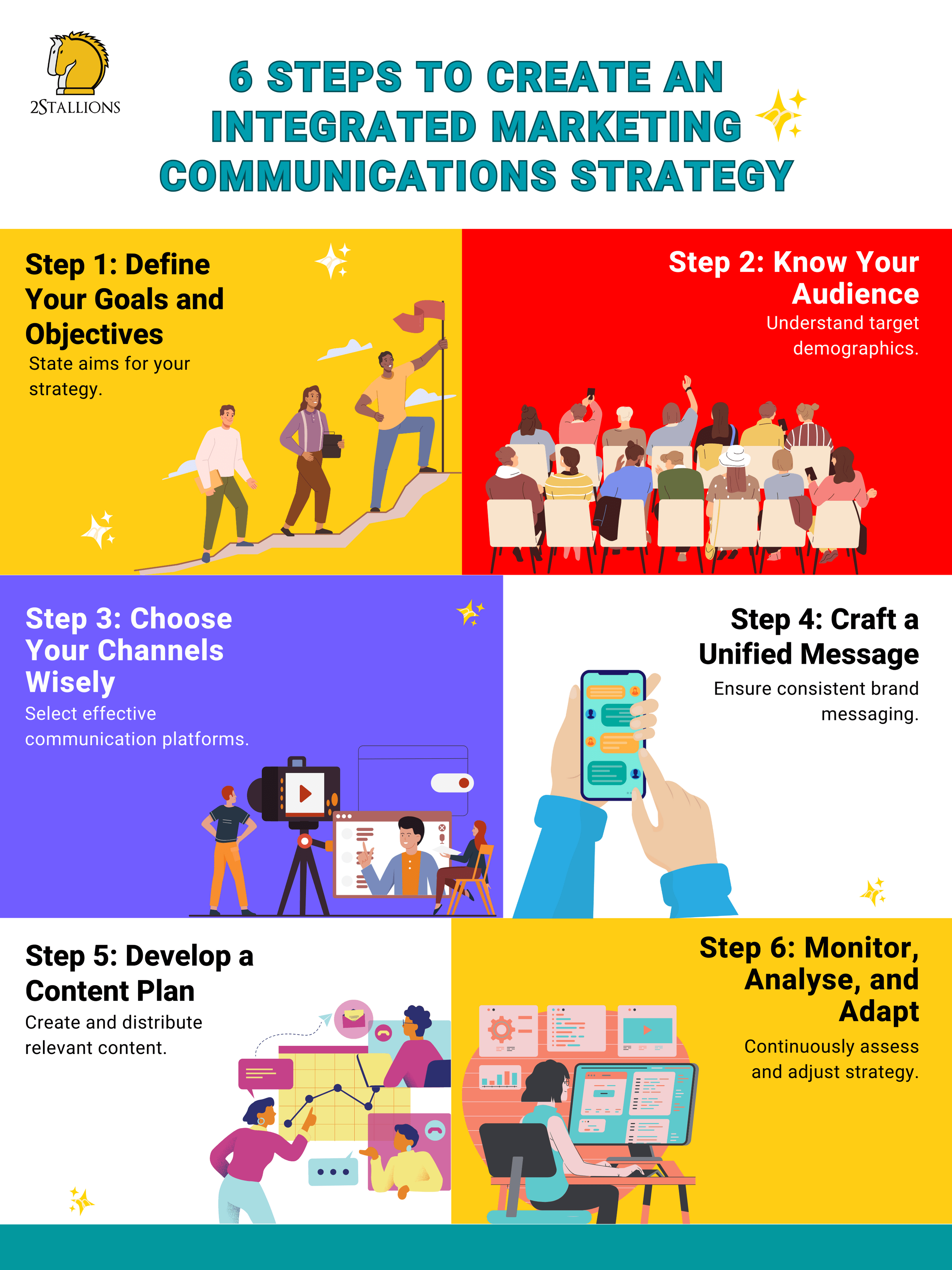 Step 1: Define Your Goals and Objectives
Step 1: Define Your Goals and Objectives
Start by clearly outlining what you aim to achieve with your IMC strategy. For instance, if the goal is to increase brand awareness, set specific objectives such as a percentage growth in online mentions or an uptick in website traffic. The key is to establish measurable and realistic goals.
Example: Increase online brand mentions by 20% within the next quarter.
Step 2: Know Your Audience
Understanding your target audience is fundamental to tailoring your message effectively. Conduct market research to identify demographics, interests, and behaviours. Create buyer personas that represent your ideal customers to guide your communication strategy.
Example: If your audience consists mainly of young professionals interested in sustainability, your messaging might emphasise eco-friendly practices and product features.
Step 3: Choose Your Channels Wisely
Select the channels that align with your audience and goals. Whether social media, email marketing, content creation, or a combination, each channel should contribute to a consistent and unified brand message.
Example: If your target audience is active on Instagram and LinkedIn, focus on creating visually appealing content for Instagram and thought leadership articles for LinkedIn.
Step 4: Craft a Unified Message
Develop a core message that resonates across all chosen channels. This message should encapsulate your brand values and unique selling propositions and resonate with your audience. Consistency is vital to building a solid and recognisable brand image.
Example: If your brand promotes a healthy lifestyle, your unified message could revolve around “Empowering Lives Through Wellness.”
Step 5: Develop a Content Plan
Create a comprehensive content plan that aligns with your unified message. This plan should encompass various content types, such as blog posts, social media updates, videos, etc. Consistent, high-quality content helps reinforce your brand message and keeps your audience engaged.
Example: If your unified message is about empowering lives through wellness, your content plan might include weekly blog posts on health tips, motivational quotes on social media, and video content featuring success stories.
Step 6: Monitor, Analyse, and Adapt
Regularly monitor the performance of your IMC strategy through analytics tools. Analyse metrics such as engagement rates, conversion rates, and customer feedback. Use these insights to adapt and refine your strategy, ensuring it remains effective and aligned with your goals.
Example: If your social media engagement is high, but website traffic is low, you may need to adjust your content distribution strategy to drive more traffic to your website.
Following these six steps, you can create an Integrated Marketing Communications strategy that resonates with your audience and strengthens your brand presence across diverse channels. Remember, the key is continuously monitoring, analysing, and adapting to the ever-evolving marketing and communication landscape.
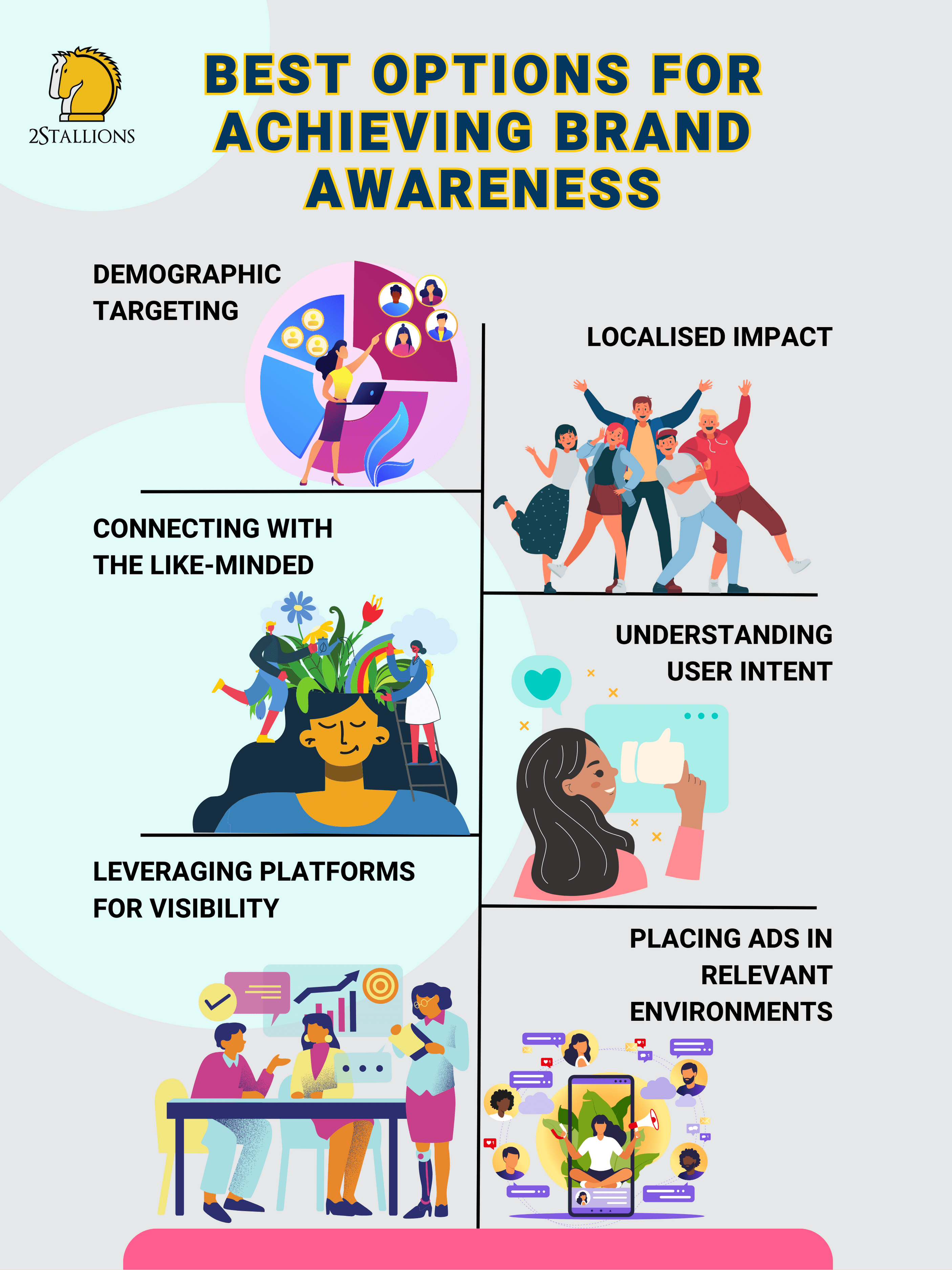 Best Options For Achieving Brand Awareness
Best Options For Achieving Brand Awareness
Selecting the right targeting option is critical in achieving brand awareness. Different platforms offer various targeting features, and understanding which aligns best with your goals can significantly impact the success of your campaign. Let’s delve into the primary targeting options and identify the most effective for enhancing brand visibility.
Demographic Targeting: Reaching the Right Audience
Demographic targeting allows you to narrow your audience based on age, gender, income, and education level. This option is handy when your brand caters to a specific demographic. Tailoring your message to resonate with the characteristics of your target audience ensures that your brand is reaching those most likely to engage with it.
Geographic Targeting: Localised Impact
For businesses with a solid local presence, geographic targeting is invaluable. This option lets you focus on specific locations, ensuring those within your target geographical area see your brand message. Whether you’re promoting a local event, a brick-and-mortar store, or a region-specific campaign, geographic targeting helps maximise the relevance of your brand to the local audience.
Interest-Based Targeting: Connecting with the Like-Minded
Interest-based targeting enables you to reach users based on their online behaviours, preferences, and interests. This option is effective for brands with products or services that align with specific hobbies, lifestyles, or consumer behaviours. Connecting with individuals already interested in related topics increases the likelihood of capturing their attention and fostering brand awareness.
Behavioural Targeting: Understanding User Intent
Behavioural targeting focuses on users’ online activities and behaviours, allowing you to tailor your message based on past interactions. This option mainly benefits brands aiming to understand and capitalise on user intent. By analysing browsing history, search patterns, and online activities, you can deliver targeted content that resonates with users’ preferences, increasing the chances of creating a lasting brand impression.
Social Media Targeting: Leveraging Platforms for Visibility
Social media platforms provide advanced targeting options based on user demographics, interests, and behaviours. With the extensive user data available on platforms like Facebook, Instagram, and X (formerly known as Twitter), advertisers can finely tune their campaigns to specific audience segments. Utilising the robust targeting capabilities of social media ensures that your brand message reaches users who are most likely to engage with and share your content.
Contextual Targeting: Placing Ads in Relevant Environments
Contextual targeting involves placing ads in environments that are thematically relevant to your brand. This method ensures that your message appears alongside content that aligns with your brand’s values and offerings. By associating your brand with contextually relevant content, you enhance the likelihood of creating a positive and memorable brand association.
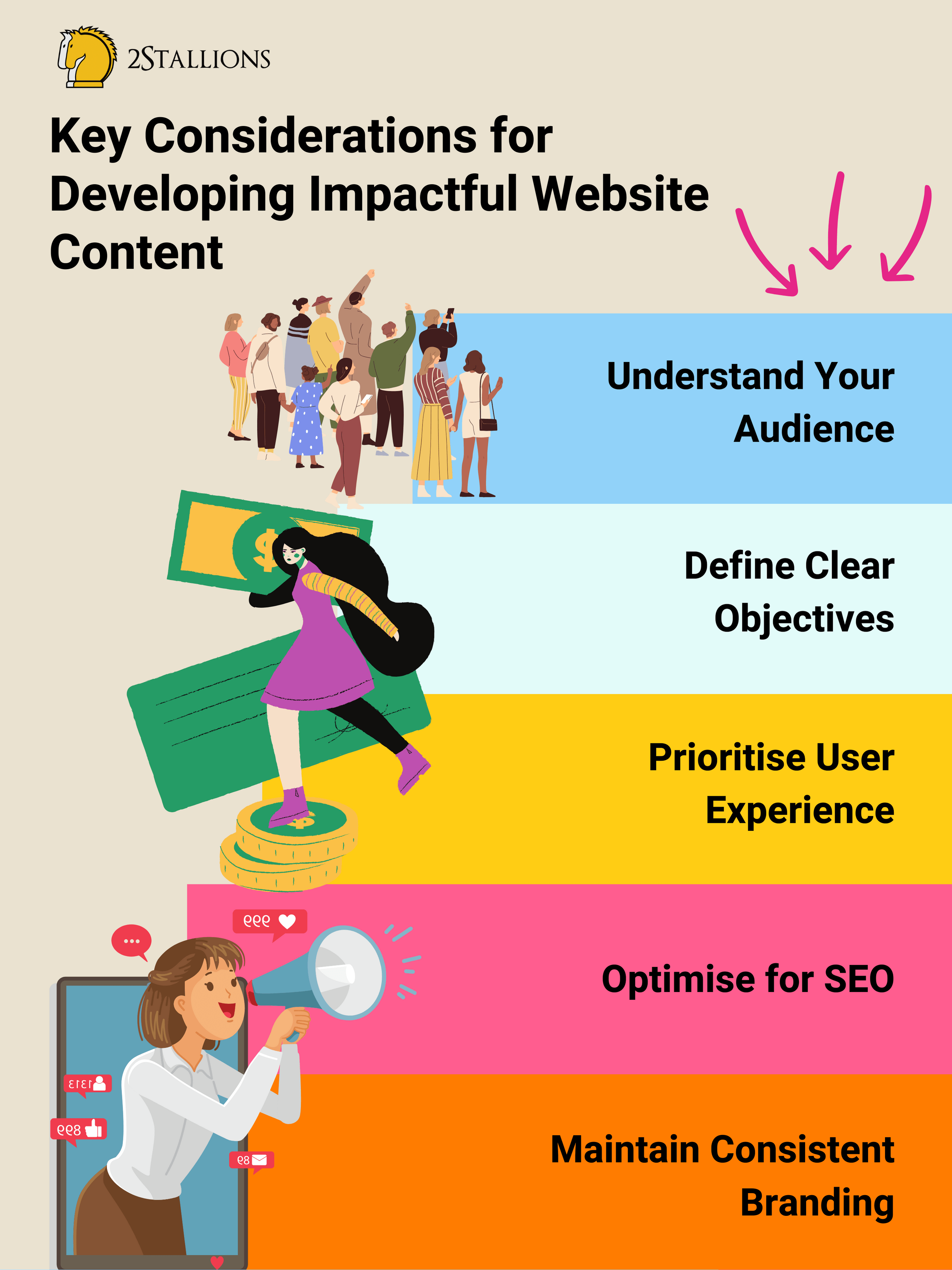 Key Considerations for Developing Impactful Website Content
Key Considerations for Developing Impactful Website Content
Crafting compelling website content is pivotal to building a solid online presence and engaging your audience effectively. Whether you’re launching a new website or revamping existing content, several key considerations can significantly impact the success of your online platform. Here’s a guide on what to consider when developing your website content:
Understand Your Audience:
Before diving into content creation, understand your target audience deeply. Identify their needs, preferences, and pain points. Tailoring your content to resonate with your audience ensures that your website speaks directly to those you aim to reach.
Define Clear Objectives:
Establish clear goals for your website content. Are you aiming to inform, entertain, sell products, or generate leads? Defining your objectives will guide your content’s tone, style, and structure, ensuring it aligns with your overarching business or organisational goals.
Prioritise User Experience (UX):
User experience is crucial for retaining visitors and encouraging them to explore your website further. Ensure your content is easy to read, visually appealing, and navigable. To enhance readability and engagement, break up text with headers, subheadings, and multimedia elements.
Optimise for SEO:
Incorporate search engine optimisation (SEO) best practices into your content strategy. Conduct keyword research to identify relevant terms and phrases and strategically integrate them into your content. This helps improve your website’s visibility on search engine results pages, driving organic traffic.
Maintain Consistent Branding:
Consistency in branding is key to building trust and recognition. Ensure your website content aligns with your brand identity, including tone of voice, imagery, and messaging. Consistent branding fosters a cohesive and memorable user experience.
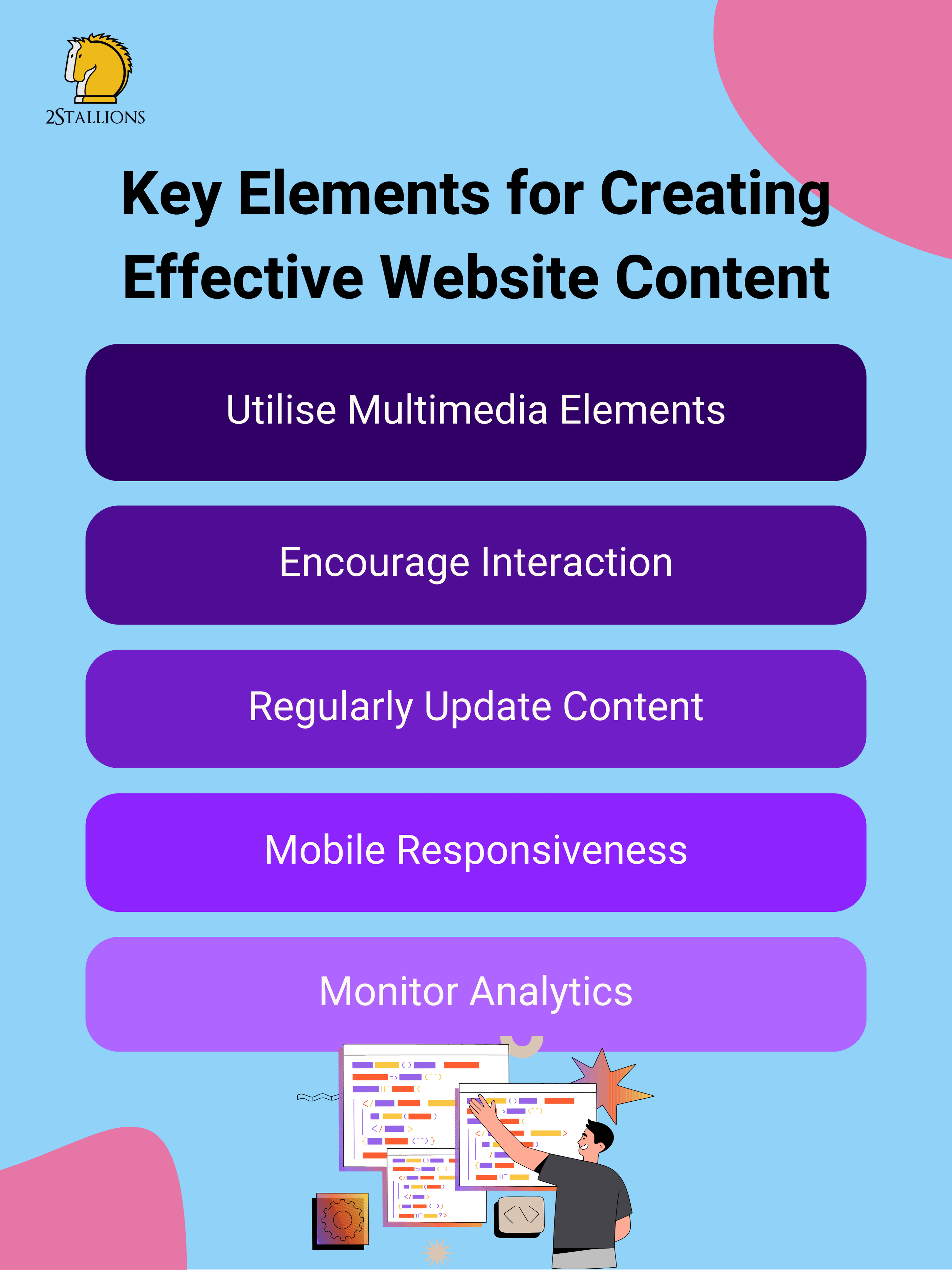 Utilise Multimedia Elements:
Utilise Multimedia Elements:
Enhance your website’s visual appeal and engagement by incorporating multimedia elements. Use high-quality images, videos, infographics, and other graphic assets to complement your written content. Visuals break up text and convey information in a more digestible format.
Encourage Interaction:
Foster engagement by including calls-to-action (CTAs) strategically throughout your content. Whether it’s prompting users to subscribe, share, comment, or make a purchase, CTAs guide visitors toward desired actions, contributing to a more interactive and dynamic website.
Regularly Update Content:
Keep your website content fresh and relevant by regularly updating it. This benefits your SEO efforts and demonstrates to visitors that your site is actively maintained and provides up-to-date information.
Mobile Responsiveness:
With the increasing use of mobile devices, ensure your website is mobile-friendly. Optimise the design and functionality to provide a seamless experience across various screen sizes and devices.
Monitor Analytics:
Utilise web analytics tools to track the performance of your content. Analyse user behaviour, page views, and other relevant metrics to understand what resonates with your audience. Use this data to refine and improve your content strategy over time.
Final Thoughts
An integrated marketing communications strategy is a powerful business aspect that will help your business stand out. Stronger brand messaging that drives your customer reach and engagement will positively impact your ROI and bottom line. Marketing can be challenging, especially when target audiences are increasingly challenging to isolate and identify. We now need to reach them across different platforms and channels, ensuring we produce specific content they find interesting and valuable. Developing an IMC can keep things straightforward and moving in the right direction.
Revolutionise Your Brand’s Reach With Our Comprehensive Online Marketing Services. Seamlessly integrate your campaigns through our powerful omnichannel marketing system for maximum impact. Experience the future of marketing with our integrated approach that ensures a cohesive and compelling brand presence across all channels.
Originally published: 12 June 2021
Updated: 9 December 2023
Frequently Asked Questions about Marketing Communications Strategy
What Are The 6 Steps In IMC Strategy?
- Define Goals and Objectives: Clearly outline your aim.
- Know Your Audience: Understand your target audience through thorough research.
- Choose Your Channels Wisely: Select channels aligned with your audience and goals.
- Craft a Unified Message: Develop a consistent, resonant core message.
- Develop a Content Plan: Create a comprehensive plan with various content types.
- Monitor, Analyse, and Adapt: Regularly assess and adjust your strategy based on performance.
What Are The 6 Ms Of Integrated Marketing Communication Strategy?
- Mission: Define the purpose and mission of your communication efforts.
- Market: Understand your target market and audience.
- Message: Craft a compelling and consistent message.
- Media: Select the appropriate channels and media for your communication.
- Money: Allocate the budget needed for your communication strategy.
- Measurement: Establish metrics to measure the success and effectiveness.
What Are The Steps In The Integrated Marketing Communications Process?
Following are the 6 steps in IMC:
- Define Goals and Objectives: Clearly outline your communication goals.
- Know Your Audience: Understand your audience through research.
- Choose Your Channels Wisely: Select channels aligned with your goals and audience.
- Craft a Unified Message: Develop a consistent message across channels.
- Develop a Content Plan: Create a comprehensive plan with diverse content.
- Monitor, Analyse, and Adapt: Regularly assess and adjust based on performance.
What Are The 6 Steps To The Communication Process In Marketing Promotion?
- Define Goals and Objectives: Clearly outline promotion goals.
- Know Your Audience: Understand your audience’s preferences and behaviours.
- Choose Your Channels Wisely: Select channels based on audience behaviour.
- Craft a Unified Message: Develop a cohesive message for promotion.
- Develop a Content Plan: Plan content aligned with promotional goals.
- Monitor, Analyse, and Adapt: Regularly assess promotion effectiveness and adjust accordingly.





